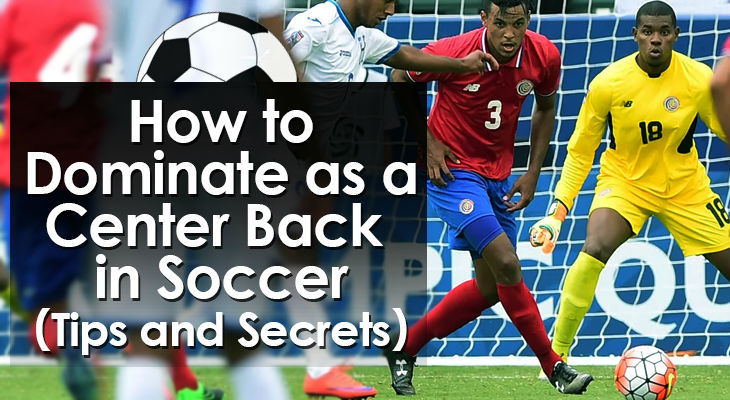What is a Center Back in Soccer? (Full Position Guide)
The "center back" is a central defender whose main duties revolve around preventing the opposition from scoring.
Operating as a pair or trio, center backs mainly defend the areas directly in front of goal and do whatever it takes to prevent strikers from scoring.
Traditional center backs were “no-nonsense” types, commanding their zone with physicality while keeping things simple on the ball.
Modern center backs still put their bodies on the line for the good of the cause, but they now do a lot more in possession. They must be capable of receiving passes under pressure, staying calm on the ball, and progressing it with crisp forward passes.
Center backs of today tend to be tall and athletic, with enough pace to match quick forwards.
As defensive lines get higher and higher each year, the need for a well-rounded center back pairing is unprecedented.
With that, let’s take a look at the position in more detail and teach you how to dominate as a center back in soccer.
What is a Center Back in Soccer?
Center backs are essentially the deepest and most important defenders on any team.
As the name suggests, they play in central defensive areas where their goal is most at risk.
Centerbacks are generally the best defenders on their teams and often use physicality, aggression, and power to contend with opposing forwards.
Their main duties involve:
- Defending the penalty box (and surrounding areas)
- Blocking shots
- Tackling
- Making clearances
- Marking strikers
- Intercepting passes
- Heading away crosses
As the defensive anchors, center backs take charge of the backline and keep teammates in check (from a defensive standpoint).
They typically sit deeper in their own half than any other defender, giving them a good vantage point to bark out instructions.
In recent years, we’ve seen a notable switch of emphasis on the type of skill set players need to succeed as a modern center back.
Today, central defenders must be willing to get on the ball, show composure in possession, and be able to whip crisp passes around the field.
Just take a look at the completed passes statistics in the world’s leading leagues...
Defenders top the charts in practically every single one!
Yes, defensive fundamentals are still crucial... but coaches seem to be favoring ball-playing center backs over more traditional defenders in the modern game.
They allow a team to build from the back, dominate possession, and gain more control over the game -- leading to better goalscoring opportunities.
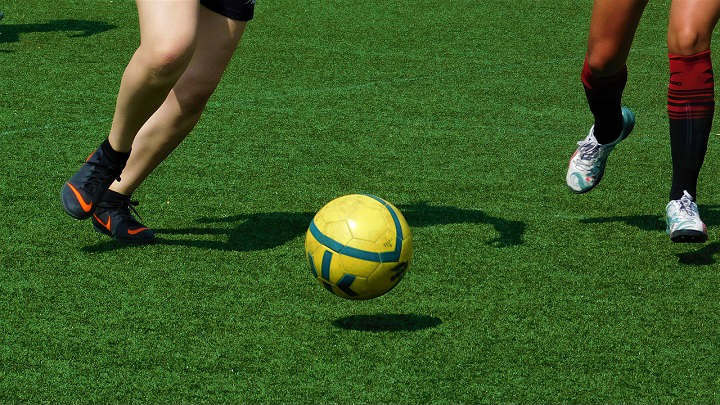
Position of a Center Back in Soccer
Center backs position themselves in the center of the field, directly in front of goal.
Position as a Duo:
When playing as a duo, center backs advance up the field and retreat backward as a unit, keeping a flat horizontal shape to avoid leaving strikers onside.
Dual center backs must stay compact to limit gaps and reduce the risk of numerical overloads.
In possession, fullbacks push forward along the sidelines and the center backs play further apart to create more space.
The midfielders often drop into the gap between the center backs to pick up the ball or offer a passing outlet.
Position as a Trio:
When center backs operate as a trio, their shape tends to be a little different...
The middle center back usually plays deeper than the other two, functioning as a defensive anchor. While the right and left center backs get a little wider, providing blanket coverage across the defensive channels.
If teams deploy three center backs, they usually play with wingbacks (advanced fullbacks) so the right and left center backs must cover the open spaces out wide.
Regardless of the formation, center backs don’t usually push forward.
While many teams play with a very high defensive line, center backs must avoid leaping out of position to engage the ball.
One missed tackle can leave the entire defense exposed.
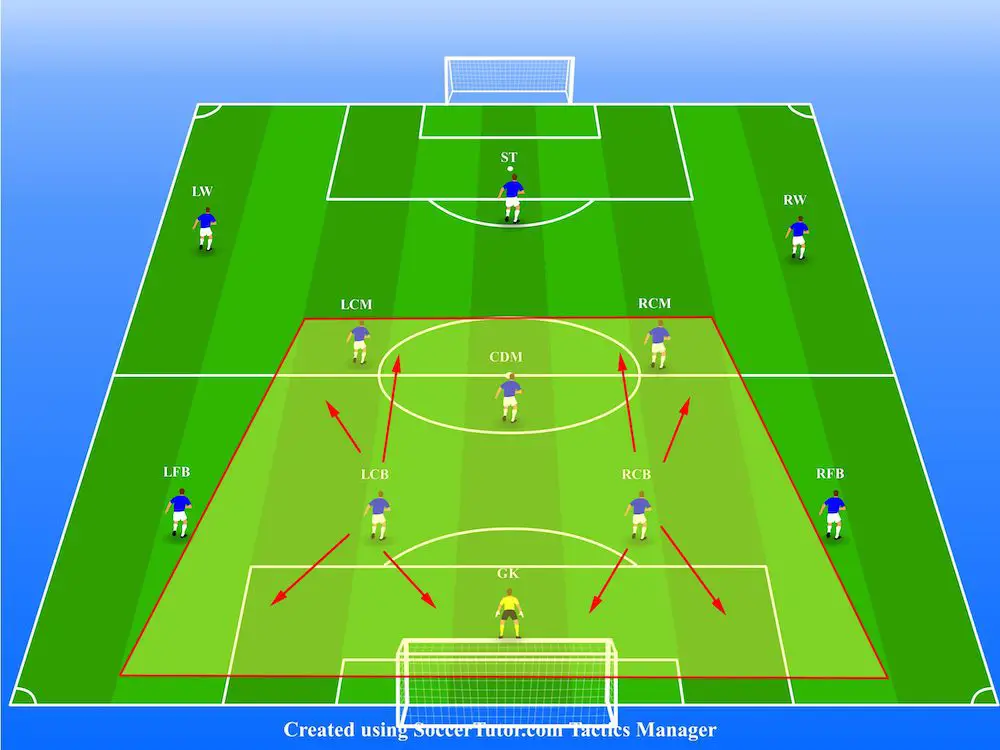
What Does a Center Back Do in Soccer?
A center back’s role is straightforward but by no means easy.
Below, I break down their main responsibilities in defense and attack.
Centerback's Role In Defense:
#1 - Defending Central Areas
Center backs’ first role is to defend the central areas and help their team keep a clean sheet.
Doing this consistently requires individual defending skills as well as teamwork and communication with the rest of the defense.
The biggest threat to any team comes through the center of the field.
Center backs routinely block, intercept, and clear balls throughout a game, eliminating the imminent danger.
They should also mark opposition strikers, especially when they’re in the penalty box.
#2 - Organize and Maintain Defensive Shape
Center backs form part of a defensive unit that must remain organized to be effective.
Central defenders are the leaders of the backline and are responsible for communicating with teammates to maintain the defensive shape.
Their instructions should be direct and clear -- almost military-like.
Miscommunication and disorganization will leave gaps for opposing strikers to exploit.
This is particularly clear during transitions when players are most likely to be out of position.
Top center backs read the game, assess the field, and get their teammates into the right places to snuff out attacks.
Organizing the backline also means providing cover for teammates when they engage the ball or step out of the defensive line.
For example, if the opposition attacks down the left wing, the left back engages the ball carrier while the nearest center back shifts across to provide cover.
The other center back and right fullback should also shuffle toward the ball to close any obvious gaps left behind.
Again, this requires positional awareness, focus, and clear communication.
#3 - Winning Individual Battles
I’ve talked at length about how center backs play as part of a cohesive defensive unit.
While this is true, each defender faces individual battles in every game.
This comes in the form of defending 1-on-1 against strikers, competing for 50/50s, chase downs, blocks, and contesting headers.
Center backs must learn how to deal with different types of strikers with varied playing styles.
For example, the best approach for strong and powerful center forwards may be to engage them as soon as they hit the ball, preventing them from turning and gaining momentum.
However, with fast and nimble strikers, this can be a dangerous approach.
Against them, it may be better to drop off, give them space, and steer them into the wide channels where another defender can provide support.
Becoming an effective 1v1 defender comes from establishing solid defensive fundamentals and learning from experiences on the field.
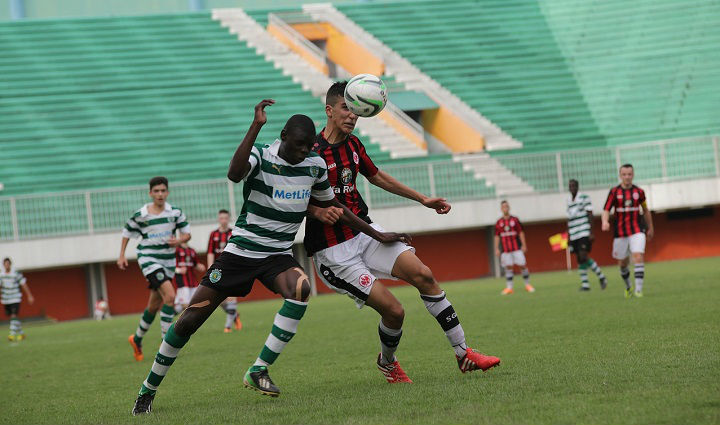
Centerback's Role In Attack:
#4 - Retaining Possession
Modern center backs are key to ball retention.
They should always be ready to receive the ball, relieving midfielders and fullbacks from pressure in congested areas.
Sometimes, simple 5-yard passes are what the team needs in order to keep the ball moving.
Center backs who are capable of progressing the ball and making line-breaking passes are a huge benefit to their teams.
Rather than taking attacking phases from A to B, their passing range allows them to go directly from A to C.
#5 - Building from the Back
The build-from-the-back philosophy is all the rage in soccer.
It provides a framework that allows a team to dominate possession and control the game.
Ball-playing center backs are essential in executing this strategy effectively.
Furthermore, with so many teams utilizing a high press, center backs must be competent and composed enough to break through it.
Today, the best center backs in the world are not only defensively astute, but also capable of playmaking from deep areas.
The likes of Sergio Ramos and Virgil Van Dijk are brick walls in defense but also capable of switching the point of attack with quality passing from inside their own half.
In truth, many top center backs have the skill set to operate effectively in midfield.
#6 - Getting Forward on Set Pieces
Center backs don’t score too often, but when they do, it tends to be from a set piece, like a corner or free kick.
Their dominant defensive attributes, like heading and winning 50/50 challenges translate directly to these types of offensive scenarios.
Apart from the goalkeeper, center backs are generally the tallest players on the field, making them a dangerous presence in either box.
Sergio Ramos, the legendary center back from Real Madrid (now PSG), is so dominant in the air that he’s amassed a total of 132 career goals.
This would be a commendable output for a striker and is an incredible achievement for a defender.
Key Traits of a Center Back
So, what does it take to become an elite center back?
Here are some traits that the best in the business share.
Players can develop and work on each of these characteristics, giving you an idea of where your focus should be during practice.
a. Positional Discipline and Reading of the Game
I’ve said it countless times before:
Being in the right place at the right time is an acquired skill and has very little to do with luck.
Center backs should be students of the game, learning to recognize patterns of play and where they should be in different scenarios.
Rather than playing on instinct alone, top defenders remain positionally disciplined and wait for an appropriate time to engage a striker or attack the ball.
Learning to read the game well allows center backs to anticipate what’s going to happen, ensuring they can act swiftly to intercept a pass, stop a cross, or block off a run.
b. Aerial Ability and Physicality
At some point, defenders will have to rely on their physical strength and aerial prowess to trump an opponent.
All center backs contend with strikers for headers -- so opponents will quickly recognize a lack of aerial ability.
Although height certainly helps in this department, shorter center backs can compete in the air with good timing and leaping ability -- both of which players can work on.
Where a center back lacks in strength, they must make up for with aggressiveness.
Example:
Lisandro Martinez, Argentina’s World Cup-winning defender, is small in stature for a center back, standing just 5’8” and weighing 169 pounds.
Yet he rarely loses out in 1v1s because of his tenacity, defensive technique, and composure.
In fact, he uses his stocky build as an advantage, leveraging a low center of gravity to throw opponents off balance and shield the ball from them.
Surprisingly, his heading statistics are some of the highest in all of Europe’s top leagues.
c. Defensive Fundamentals
Naturally, a center back must have excellent defensive fundamentals.
Two of the most important factors in developing solid defensive fundamentals are:
#1 - Balance
#2 - Control
Whether they’re blocking a shot, tackling an opponent, or competing for a 50/50, defenders must demonstrate balance and control.
This not only increases their chances of success in the moment, but it also allows them to recover quickly if they come out second best.
As a rule of thumb, going to ground with a slide tackle should be a last resort.
d. Timing and Decision Making
Timing is everything in tough defensive scenarios.
A mistimed tackle or late lunge can take a defender out of the sequence and leave the backline exposed or overrun.
In 1v1s, center backs must know when to bite and when to stand off.
For example:
If the center back is the last line of defense between an attacker and the goal, they should guide the forward away from goal until a teammate can offer support.
If an opponent receives the ball on the halfway line and begins to surge forward, a center back may choose to engage them before they build momentum.
(As long as they have support behind them!)
e. Leadership
There is no room to hide as a center back.
By its very nature, the position requires bravery and accountability.
Perhaps this is the reason so many center backs are leaders on the pitch.
Fun fact: Center backs are by far the most captained position among Europe’s top soccer leagues!
Quality leadership comes in a variety of forms.
First, center backs must lead by example through work rate and performance standards.
Second, they need to reflect the coach's instructions on the field, guiding teammates and adhering to their tactics.
Finally, great leaders know how to encourage teammates and raise their levels.
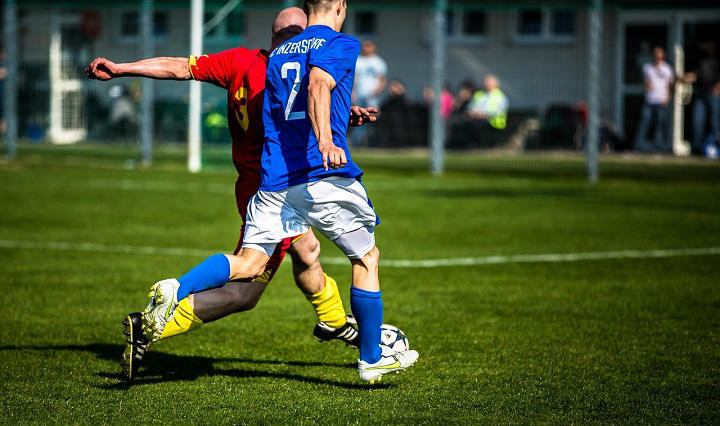
Best Center Backs of All Time
The center back role has evolved considerably over the years.
Yet some players transcend eras.
Here is my list of top 10 center backs of all time:
- Franz Beckenbauer
- Franco Baresi
- Bobby Moore
- Alessandro Nesta
- Sergio Ramos
- Ronald Koeman
- Jaap Stam
- Rio Ferdinand
- Paolo Maldini
- Marcel Desailly
5 Bonus Tips for Center Backs
As the game continues to evolve, up-and-coming players face fresh challenges in every position.
Check out these pro tips if you want to step up your game and begin to dominate as a center back in soccer.
#1 - Perform Situational Training
Situational training is important for defenders to learn how to approach specific scenarios in a game.
As a center back, you should practice 1v1s, defending crosses, engaging attackers in wide areas, and defending as a unit against waves of attackers.
If possible, you should also practice training against strikers with different skill sets.
That way, you’ll be ready to come up against a variety of opposition, from tall target-man strikers to smaller tricky forwards.
#2 - Establish a Strength and Conditioning Routine
You'll need strength and stamina to face tough strikers for 90 minutes week in and week out.
Establishing a strength and conditioning routine with a qualified trainer helps you build the physique and fitness required to meet these demands.
Maintaining a strong body also lowers the risk of picking up injuries throughout the season.
Just be sure to give yourself time to recover!
Overtraining is a common cause of injury and can jeopardize your career.
#3 - Become a Master Reader of the Game
Becoming an excellent reader of the game is one of the best things you can do as a center back.
It directly improves your positioning, anticipation, and decision-making, enabling you to stand out every time you take to the field.
Being a step ahead of your opponent can even make up for physical deficits, such as a lack of pace, height, or strength.
To become a master reader of the game, you must study patterns of play, gain an understanding of how different formations work, and analyze top center backs in world soccer.
#4 - Focus on Developing Ball Skills
Modern defenders must not ignore the importance of developing on-the-ball technical skills.
Technically gifted center backs are in high demand among all soccer teams at every level.
If you’re lacking in key areas, be sure to practice drills in your backyard to hone your skills.
Important attributes to focus on include first touch, passing, dribbling, and heading.
#5 - Study Strikers
One overlooked part of becoming a dominant defender is studying the enemy.
In addition to learning from other center backs, you should also pay attention to what strikers do.
Identify how certain players move, their tendencies, how they find space, and where they look to receive the ball.
This type of knowledge will help you to get early reads in a game and quickly identify how your opponent likes to play.
Armed with that information, you can force the opposition towards their weaknesses and away from their strengths.
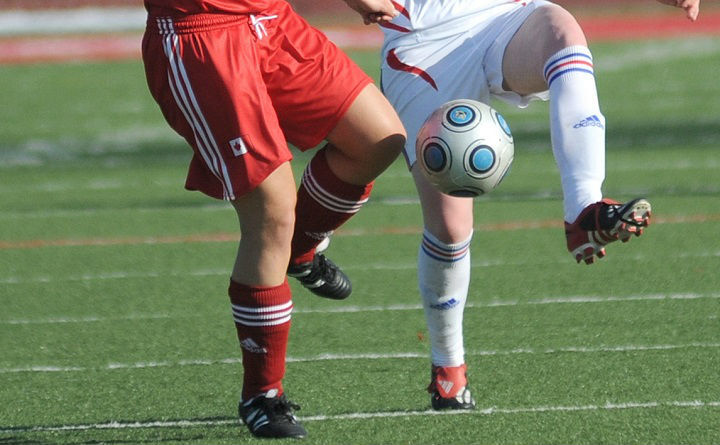
Conclusion
The modern center back role demands versatility.
It’s no longer enough to command the backline with force and aggressiveness alone.
Center backs must be technically savvy and composed with the ball at their feet.
Mentality is also key in this position and center backs must lead by example.
Through focused training, hard work, and off-the-field study, you can take your game to new heights very quickly.

